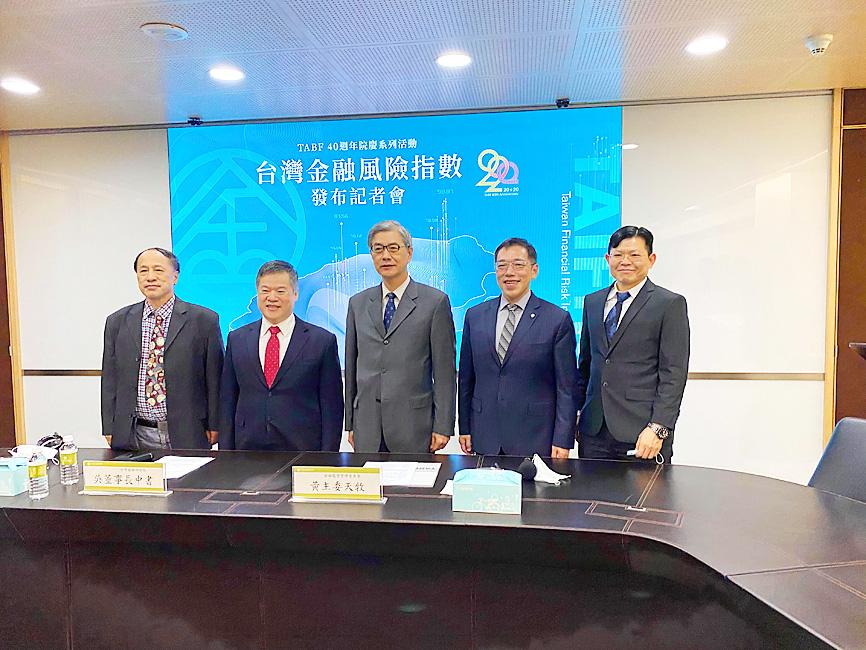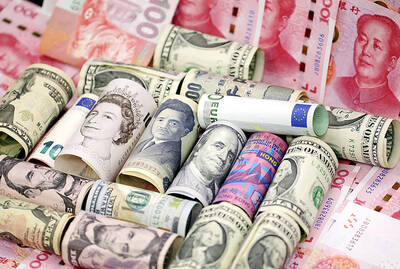The nation’s financial risks remain low, but rising housing prices, lending risks in banks’ overseas branches and stock market volatility need to be monitored, the Taiwan Academy of Banking and Finance (TABF, 台灣金融研訓院) said yesterday at the launch of its Taiwan Financial Risk Index.
The index fell to 98.11 last month, from 98.71 a month earlier and 101.28 in March, indicating that financial risks had been declining since the COVID-19 outbreak, TABF president Hank Huang (黃崇哲) told a news conference in Taipei.
However, it has not returned to pre-pandemic levels, with the index standing at 97.85 in January, Huang said.

Photo: Wu Chia-ying, Taipei Times
The nation’s first self-developed financial risk indicator, the index is composed of four sub-indices: asset valuation risk, systemic stress in the financial sector, potential instability in the non-financial sector, and spillover and contagion risks.
A reading of below 100 indicates low financial risks, while a reading above the threshold suggests higher risks, the nonprofit organization said.
The institute spent two years compiling the index based on the European Central Bank’s financial stability risk index.
It helps regulators enhance supervision and benefits academic research, Financial Supervisory Commission Chairman Thomas Huang (黃天牧) said.
A closer look at the index shows that asset valuation risk, which measures volatility in the stock market, real-estate market and corporate debt, was 101.63 last month, down from 103.4 in October.
However, it remained above 100, reflecting an overheated property market, with rising housing prices and commercial office rents, the institute said.
Systemic stress in the financial sector — calculated based on banks’ loan-to-deposit ratio, capital adequacy, non-performing loan ratio and coverage ratio — fell from 95.4 to 94.2, while stability in the non-financial sector — based on banks’ corporate loans and investment in corporate bonds — also slid from 93.6 to 92.9, it said.
However, spillover and contagion risks climbed to 104.3 from 103.4, ending a three-month decline, as more countries saw a spike in COVID-19 cases, boosting the risks for loans by banks’ overseas branches, TABF said.
Still, it was lower than the peak of 113.2 in March, the data showed.

Taiwan’s rapidly aging population is fueling a sharp increase in homes occupied solely by elderly people, a trend that is reshaping the nation’s housing market and social fabric, real-estate brokers said yesterday. About 850,000 residences were occupied by elderly people in the first quarter, including 655,000 that housed only one resident, the Ministry of the Interior said. The figures have nearly doubled from a decade earlier, Great Home Realty Co (大家房屋) said, as people aged 65 and older now make up 20.8 percent of the population. “The so-called silver tsunami represents more than just a demographic shift — it could fundamentally redefine the

The US government on Wednesday sanctioned more than two dozen companies in China, Turkey and the United Arab Emirates, including offshoots of a US chip firm, accusing the businesses of providing illicit support to Iran’s military or proxies. The US Department of Commerce included two subsidiaries of US-based chip distributor Arrow Electronics Inc (艾睿電子) on its so-called entity list published on the federal register for facilitating purchases by Iran’s proxies of US tech. Arrow spokesman John Hourigan said that the subsidiaries have been operating in full compliance with US export control regulations and his company is discussing with the US Bureau of

Taiwan’s foreign exchange reserves hit a record high at the end of last month, surpassing the US$600 billion mark for the first time, the central bank said yesterday. Last month, the country’s foreign exchange reserves rose US$5.51 billion from a month earlier to reach US$602.94 billion due to an increase in returns from the central bank’s portfolio management, the movement of other foreign currencies in the portfolio against the US dollar and the bank’s efforts to smooth the volatility of the New Taiwan dollar. Department of Foreign Exchange Director-General Eugene Tsai (蔡炯民)said a rate cut cycle launched by the US Federal Reserve

Businesses across the global semiconductor supply chain are bracing themselves for disruptions from an escalating trade war, after China imposed curbs on rare earth mineral exports and the US responded with additional tariffs and restrictions on software sales to the Asian nation. China’s restrictions, the most targeted move yet to limit supplies of rare earth materials, represent the first major attempt by Beijing to exercise long-arm jurisdiction over foreign companies to target the semiconductor industry, threatening to stall the chips powering the artificial intelligence (AI) boom. They prompted US President Donald Trump on Friday to announce that he would impose an additional